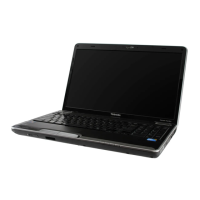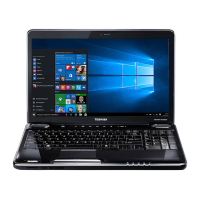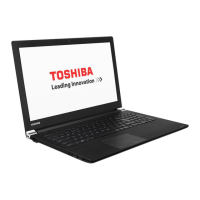
Do you have a question about the Toshiba Satellite A505-SP6986C and is the answer not in the manual?
| Processor | Intel Core i5-430M |
|---|---|
| RAM | 4GB |
| Storage | 500GB HDD |
| Graphics | Intel Graphics Media Accelerator HD |
| Operating System | Windows 7 Home Premium |
| RAM Type | DDR3 |
| Screen Size | 16.0 inches |
| Screen Resolution | 1366 x 768 |
| Graphics Card | Intel HD Graphics |
Instructions for backing up important data to prevent loss from device failures or errors.
FCC compliance statement for radio frequency devices, detailing limits for radiation and potential interference.
FCC regulations concerning internal modems, including specific numbering and equivalence requirements.
Information on RF exposure from wireless devices and guidelines for minimizing potential health risks.
Discusses the health effects of wireless LAN emissions, comparing them to mobile phones.
Information on the WEEE Directive, product recycling, and responsible disposal of electronics.
List of regions and countries where the Intel Wireless Wi-Fi adapter is approved for use.
Specific restrictions on using 2.4 GHz frequencies in European countries, including licensing requirements.
Restrictions for 5 GHz band usage in Europe, covering indoor/outdoor use and specific channels.
Discusses the health effects of Bluetooth devices and safety recommendations.
Copyright notice for the user manual, reserving all rights to Toshiba.
Provides an overview of the computer's functions and how to use the manual effectively.
Steps for setting up the computer, including connecting external components and initial software setup.
Instructions on how to connect the computer to an AC power source using the adapter and power cable.
Guidance on how to charge the main battery before first use and maintain its performance.
Step-by-step guide on how to power on the computer and initial system loading.
How to connect and install optional external devices like printers, mice, and external monitors.
Detailed steps for installing or removing memory modules to upgrade the computer's RAM.
Guide on using the TouchPad for cursor control, navigation, and button functions.
Instructions for connecting and using external displays like TVs, projectors, or monitors.
Steps for connecting and setting up a printer, including software installation.
Instructions on how to properly shut down the computer using Windows options.
Explanation of the hibernation mode, how it saves system state, and its benefits.
Explanation of the sleep mode, how it conserves power, and how to resume work.
How to customize computer settings, including power management and system options.
Tips on how to clean, maintain, and protect the computer from damage.
Offers tips for efficient computer use, emphasizing frequent saving and regular backups.
Explains keyboard layout, character keys, function keys, and special Windows keys.
Guides on launching applications using various methods like Start Menu, Explorer, and search.
Stresses the importance of saving work frequently to prevent data loss from unexpected events.
Details on creating backups of important files and the entire system for data protection.
Instructions for using the optical drive for CD/DVD playback and data storage.
Toshiba's design approach emphasizing energy efficiency for extended battery life.
Guidance on operating the computer using battery power and understanding battery management.
Instructions for charging the main battery and the RTC battery.
Tips and strategies for extending battery operational time by managing power consumption.
Detailed instructions for safely removing and replacing the computer's main battery.
Safety precautions and maintenance tips for handling and prolonging battery life.
Guidelines for environmentally responsible disposal of used batteries, including safety measures.
Recommendations for safely transporting and using the computer while traveling, including airport security.
An overview of the Windows desktop environment, including its main components.
Setting up the computer for communication, including internet and network connections.
How to utilize the built-in wireless LAN for network access and communication.
Steps for connecting the computer to wired (Ethernet) or wireless networks.
An introduction to the Internet, the World Wide Web, and basic online activities.
Overview of the computer's audio capabilities, including recording and playback features.
Information on inserting and removing ExpressCard modules for expanded functionality.
Using the media card reader slot for various memory card types.
A utility for quick access to computer functions and personalizing system settings.
Utilities for enhancing system security, such as password management.
Utilities for PC diagnostics, hard drive protection, and system repair functions.
Utilities aimed at improving system performance, like memory card formatting and hardware configuration.
Procedures for setting up and managing instant, power-on, supervisor, and user passwords.
Using fingerprint verification for logging into the computer as an alternative to passwords.
A service utility that notifies users of software, firmware, and documentation updates.
A utility that monitors system functions like power consumption and cooling, providing alerts.
A utility suite for managing communication devices and network connections, including profile creation.
Basic troubleshooting steps for common issues like unresponsive programs and system startup failures.
Troubleshooting steps for issues related to powering on the computer or system startup problems.
Resolving issues when the Windows OS fails to start or respond correctly.
Common internet connectivity problems, including slow speeds and browser errors.
Steps to identify and resolve conflicts between hardware devices, drivers, and system resources.
Troubleshooting memory-related errors caused by improper installation or faulty modules.
Diagnosing power-related problems involving the AC adapter, power cable, and batteries.
Resolving display problems such as a blank screen or flickering.
Troubleshooting issues with the internal storage drive or external floppy drive access.
Resolving issues related to DVD playback, disc compatibility, and optical drive functionality.
Guidance on seeking further technical assistance and contacting support resources.
Information on Toshiba shortcut keys and cards for system modification and application launch.
How to use direct key cards to control system functions like volume and display.
How to use application cards to launch specific software programs.
How to use direct key cards by pressing Fn in combination with function keys.
How to use application cards to launch specific software programs via the Fn key.
Explains direct key functions activated by Fn key combinations for system control.
How to enable or disable wireless devices like Wi-Fi and Bluetooth using direct keys.
How to enable or disable the TouchPad using a direct key function.
How to change screen resolution using direct key functions.
Illustrations and homologation information for AC power connectors used in different countries.
A list of common acronyms and abbreviations used in the manual with their definitions.
Definitions of technical terms and concepts related to computer hardware and software.












